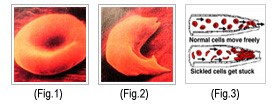I have always been a strong proponent for knowing your family health history. Genealogists should be aware of the advantage of using genetics to not only make a familial connection, but also uncover possible links to hereditary diseases and ailments. Consequently, my focus for September is National Sickle Cell Awareness Month because of my own health history. As a carrier of the trait, which is usually asymptomatic, I was one of the few that had milder symptoms of the disease. As a child I remember suffering painful episodes that were attributed to “growing pains”. Only now do I realize that these were not in my head, and I have had bouts of anemia through my adult life. Although there are very few who know about the disease, there are approximately 100,000 people suffering with the condition in the United States alone.
What is Sickle Cell Disease?
Sickle cell disease (SCD) is a genetically inherited blood disorder. There are several different forms of SCD, and the most common and usually the most severe form is sickle cell anemia.
- Normal red blood cells are round like doughnuts, and they move through small blood tubes in the body to deliver oxygen. (fig.1)
- Sickle red blood cells become hard, sticky and shaped like sickles used to cut wheat. (fig.2)
- When these hard and pointed red cells go through the small blood tube, they clog the flow and break apart. This can cause pain, damage and a low blood count, or anemia. (fig.3) (Proudford, 2014, para. 2)
My father was aware that he carried the sickle cell trait, and he was adamant that I be tested for it as an infant. I knew since I was younger what that meant, but by the time I was old enough to have children of my own I forgot about the potential to pass the disease to my own children. “The sickle cell gene is passed from generation to generation in a pattern of inheritance called autosomal recessive inheritance. This means that both the mother and the father must pass on the defective form of the gene for a child to be affected” (Causes, 2014). That being said, my father had to inherit the trait from one of his parents, and so on. I happen to know that it was my paternal grandmother, so it was passed to her from one of her parents, but I don’t know which one. In a case where I was uncertain of parentage the condition would be able to help me narrow down my list. Unfortunately, many of the death certificates that I research do not list sickle cell as a contributing factor as a cause of death, and in the example of my paternal family, many of them died from heart disease. I wonder if I would be able to determine if death was a result of end organ disease and undiagnosed SCD or a predisposition to heart disease?

There are many clues in my genealogical research that force me to pay attention to my own health, specifically when I see the diseases and conditions my ancestors suffered from. The study of genetic genealogy allows me to take my research one step beyond what I see in records. However, the standard DNA tests that are available today for genealogy do not test the markers that show genetic diseases. I believe it is just as important for genealogists to leave a legacy of medical information for their descendants because knowing this history can save their life. Therefore, in my own family pedigree charts I always include the cause of death along with other vital information, which also makes it easier for me to create a chart to show patterns of ailments and diseases. There are also web-based tools for those who feel comfortable storing this information online. The Surgeon General’s Family History Initiative was created to encourage all American families to learn more about their family health history. “My Family Health Portrait Tool” can be found online at https://familyhistory.hhs.gov/fhh-web/home.action.

Today, not only do we understand that such uncommon diseases as sickle cell are hereditary, but that even common ailments such as diabetes, many cancers, and heart disease may also have a genetic link. Making a pedigree chart, taking the simple blood tests, and registering for the marrow donor lists can make a difference in your own family health history, as well as those who are affected with similar conditions. It could mean alleviating unnecessary pain and suffering, or possibly life and death.
Next month I will continue in the series of genetic genealogy for Breast Cancer Awareness Month. “Currently the National Institutes of Health (NIH), through its Human Genome Project, is mapping the 100,000 genes in the human cell. We now know, for instance, that a woman with a certain damaged gene, BRCA1, has a 90% chance of getting breast cancer during her lifetime. If a search through your family tree shows a high incidence of breast cancer, then this gene may be lurking in your pedigree” (NGS, para. 7, 2013).
Read more specifics about sickle cell disease at http://www.examiner.com/article/national-sickle-cell-disease-awareness-month
References
Committee on Genetic Genealogy. (2014). Retrieved September 2014, from http://www.ngsgenealogy.org/cs/genetic_genealogy_committee
Sickle Cell Anemia, Causes. (2014) Retrieved September 2014, from http://www.mayoclinic.org/diseases-conditions/sickle-cell-anemia/basics/causes/con-20019348
Genetics and Genealogy. (Feb 2013). Retreived September 2014, from http://www.kerchner.com/books/introg&g.htm
What is sickle cell disease? (2014). Retrieved September 2014, from http://www.wepsicklecell.org/about/.

